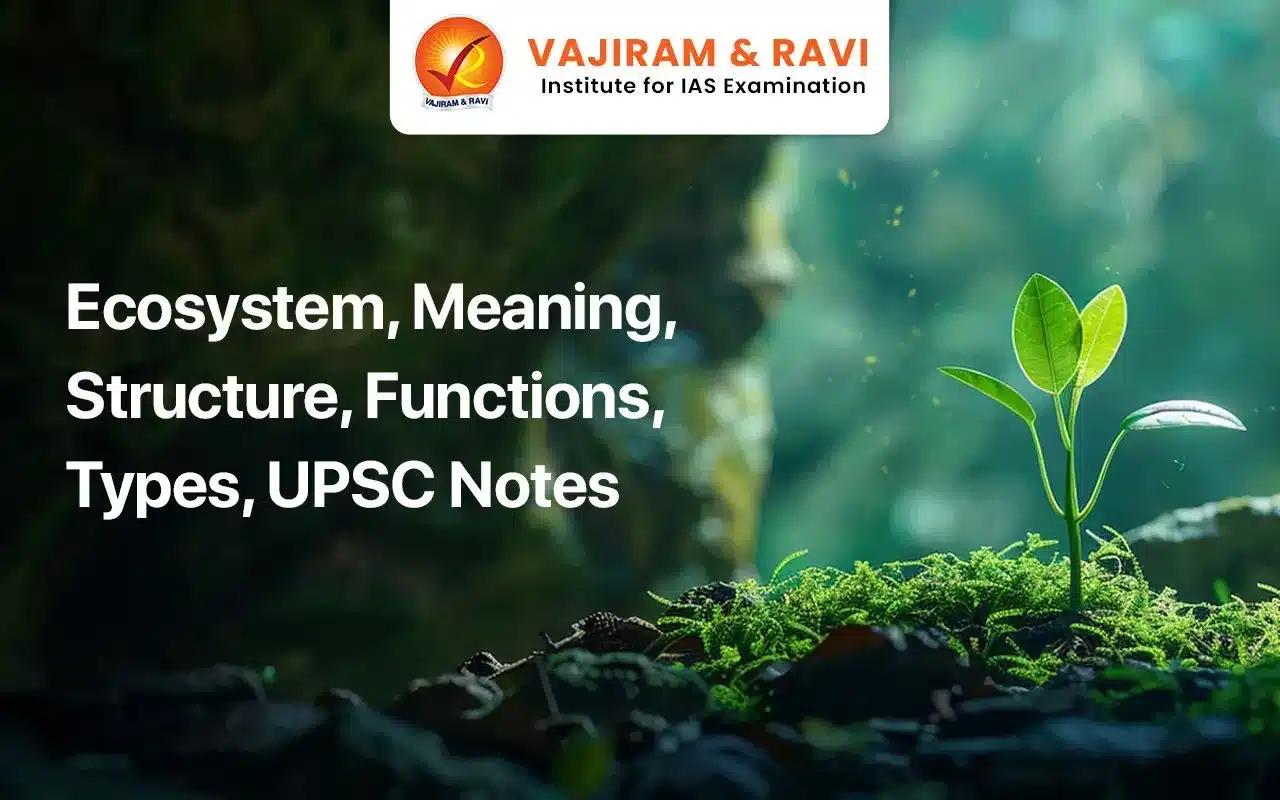Components of Ecosystem
An ecosystem consists of two main components: biotic and abiotic.- Biotic components: These are the living organisms present in an ecosystem, including:
- Producers (autotrophs): Organisms that produce their food through photosynthesis (plants, algae, and certain bacteria) are autotrophs. They form the base of the food chain and are essential for energy flow in ecosystems.
- Consumers (heterotrophs): These are organisms that consume other organisms for food.
- Primary consumers (herbivores): Organisms that feed directly on producers. Examples: deer, rabbits, grasshoppers, etc.
- Secondary consumers (carnivores): Organisms that feed on primary consumers. Examples: snakes, foxes, owls etc.
- Tertiary consumers (top predators): Organisms at the top of the food chain that feed on secondary consumers. Examples: lions, sharks, eagles, humans, etc.
- Decomposers (detritivores): Organisms that break down dead organic matter, releasing nutrients back into the ecosystem. Examples: bacteria, fungi, earthworms). They play a crucial role in nutrient cycling.
- Keystone species: These are species that play a disproportionately large role in maintaining the structure and functioning of an ecosystem relative to their abundance.
- Their removal or decline can have cascading effects on the entire ecosystem.
- Ecological Niche: A niche is the functional role or position of a species within an ecosystem, including its behaviour, activities, and interactions with the biotic and abiotic environment.
- Each species occupies a unique niche, allowing for coexistence and efficient resource utilisation.
- Abiotic components: These are the non-living physical and chemical factors present in an ecosystem, including Sunlight, Temperature, Water, Soil, Air, Minerals and Nutrients.
Types of Ecosystem
Ecosystems can be classified based on various factors, such as their physical characteristics, location, and dominant species. Here are some common types of ecosystems:- Terrestrial Ecosystems:
- Forest Ecosystems (tropical rainforests, temperate forests, boreal forests)
- Grassland Ecosystems (savannas, prairies, steppes)
- Desert Ecosystems (hot and cold deserts)
- Tundra Ecosystems (Arctic tundra, Alpine tundra)
- Aquatic Ecosystems:
- Freshwater Ecosystems (lakes, rivers, ponds, wetlands)
- Marine Ecosystems (oceans, coral reefs, estuaries, mangroves)
- Artificial Ecosystems:
- Urban Ecosystems (cities, parks, gardens)
- Agricultural Ecosystems (croplands, pastures, orchards)
Ecotone
Ecotone is a transition zone between two ecosystems, varying in width and occurring locally or regionally.- It hosts species from both adjacent ecosystems and includes examples like marshlands, mangrove forests, and estuaries.
- Generally, the biodiversity in an ecotone is higher than the two constituting ecosystems. This is called the edge effect.
Functioning of Ecosystem
Ecosystems function through various processes and interactions between their biotic and abiotic components. These processes include the flow of energy and material (nutrients) among the components of the ecosystem, which are essential for maintaining the balance and sustainability of the ecosystem.Productivity
Ecosystems rely on solar energy, which plants convert into biomass through photosynthesis, a process known as Primary Production. The rate of this production is called Productivity.- Standing crop and Biomass: Standing crop refers to the mass of living material (organisms) at a specific time within a trophic level.
- It can be measured either as biomass (fresh or dry weight) or as the number of organisms per unit area.
- Measuring biomass in terms of dry weight is more accurate because it accounts for variations due to water content.
- Productivity is categorised into:
- Gross Primary Productivity (GPP): It is the total organic matter produced by photosynthesis. Plants use a portion of this for respiration.
- Net Primary Productivity (NPP): The remaining organic matter after subtracting respiration from GPP, is available for consumption by heterotrophs (herbivores and decomposers) and is called NPP.
- Secondary Productivity: The rate at which consumers form new organic matter.
- Factors for high NPP: Types of plant species, environmental conditions, nutrient availability and photosynthetic capacity influence productivity. Hence, it varies across ecosystems.
- Coral Reefs and Tropical Rainforests have high productivity.
- Total annual NPP of the biosphere: It is about 170 billion tons of organic matter.
- Despite covering 70% of the Earth, oceans contribute only 55 billion tons, with the rest coming from land.
Energy Flow
Energy is the driving force that sustains life in ecosystems. The primary source of energy is the sun, and this energy is transferred through the ecosystem via food chains and food webs.- Trophic levels: Organisms in an ecosystem occupy specific positions based on their feeding relationships. These positions are called trophic levels.
- The trophic levels include Producers (Autotrophs), Primary consumers (Herbivores), Secondary consumers, and Tertiary consumers.
- 10% Law and Energy transfer: Approximately 10% of energy is transferred from one trophic level to the next in a food chain.
- As energy flows through the food chain, some are lost as heat during metabolic processes and due to inefficiencies.
- Consequently, the number of trophic levels in an ecosystem is limited by the available energy.
- Energy flows unidirectionally from the sun to producers and then to consumers.
- This process aligns with the first law of thermodynamics (conservation of energy).
- Food Chains and Webs: These represent the energy flow in an ecosystem, from producers to the top predators.
- A food chain is a linear sequence of organisms where each organism is consumed by the next at the higher trophic level.
- A food web is a network of interconnected food chains that show more complex interactions.
- Organisms depend on producers directly or indirectly for their food.
- Types of food chains: Grazing food chain, Detritus food chain, and Parasitic food chain.
- Ecological Pyramid: These are graphical representations that illustrate the relative amounts of producers, consumers, and energy at different trophic levels in an ecosystem.
- Types of Pyramids: Pyramid of Biomass, Pyramid of Numbers, and Pyramid of Energy.
Nutrient Cycle
Nutrient cycling is the continuous movement and exchange of essential elements (carbon, nitrogen, phosphorus, sulfur, water, etc.) between the biotic and abiotic components of an ecosystem. These cycles are driven by various biological, geological, and chemical processes.- Hydrological cycle: Also known as the water cycle, it is the continuous movement of water through different reservoirs on Earth, including the atmosphere, surface water, groundwater, and living organisms.
- It involves processes such as evaporation, transpiration, condensation, precipitation, and surface runoff.
- Carbon cycle: This involves the movement of carbon dioxidebetween the atmosphere, biosphere (living organisms), hydrosphere (water bodies), and lithosphere (Earth's crust and mantle).
- The main processes involved are photosynthesis, respiration, decomposition, combustion, and geological processes like weathering and volcanic activity.
- Nitrogen cycle: This is the continuous transformation and transfer of nitrogen between the atmosphere, biosphere, and lithosphere.
- Key processes include nitrogen fixation (conversion of atmospheric nitrogen into usable forms), nitrification (conversion of ammonia to nitrites and nitrates), and denitrification (conversion of nitrates back to atmospheric nitrogen).
- Phosphorus cycle: Phosphorus is primarily obtained from rocks and minerals through weathering processes.
- It is then taken up by plants, consumed by animals, and returned to the environment through decomposition and excretion.
- Sulphur cycle: Sulphur is released into the atmosphere through volcanic activity and industrial processes, and it is taken up by plants and microorganisms.
- It is then cycled through the ecosystem through processes like decomposition, respiration, and precipitation.
Ecological Succession
Ecological succession is the gradual process by which communities of plant and animal species in an ecosystem are replaced over time, leading to a relatively stable climax community. There are two main types of ecological succession:- Primary succession: This refers to the gradual development of a biotic community in a previously uninhabited and barren habitat, such as a new rock face or sand dunes.
- The process is typically slow due to the lack of existing life and organic matter.
- Secondary succession: This occurs in areas where a pre-existing biotic community has been disrupted or destroyed, like abandoned farmlands or burned forests.
- As some soil or sediment is already present, this type of succession progresses faster than primary succession.
Ecosystem UPSC PYQs
Question 1: Define the concept of carrying capacity of an ecosystem as relevant to an environment. Explain how understanding this concept is vital while planning for sustainable development of a region. (UPSC Mains 2019) Question 2: Which one of the following is the best description of the term ‘ecosystem’? (UPSC Prelims 2015)- A community of’ organisms interacting with one another
- That part of the Earth which is inhabited by living organisms
- A community of organisms together with the environment in which they live
- The flora and fauna of a geographical area
- A food chain illustrates the order in which a chain of organisms feed upon each other.
- Food chains are found within the populations of a species.
- A food chain illustrates the numbers of each organism which are eaten by others.
- 1 only
- 1 and 2 only
- 1, 2 and 3
- None
- Oceans, lakes, grasslands, mangroves
- Mangroves, oceans, grasslands, lakes
- Mangroves grasslands, lakes, oceans
- Oceans, mangroves, takes, grasslands
Last updated on November, 2025
→ Check out the latest UPSC Syllabus 2026 here.
→ Join Vajiram & Ravi’s Interview Guidance Programme for expert help to crack your final UPSC stage.
→ UPSC Mains Result 2025 is now out.
→ UPSC Notification 2026 is scheduled to be released on January 14, 2026.
→ UPSC Calendar 2026 is released on 15th May, 2025.
→ The UPSC Vacancy 2025 were released 1129, out of which 979 were for UPSC CSE and remaining 150 are for UPSC IFoS.
→ UPSC Prelims 2026 will be conducted on 24th May, 2026 & UPSC Mains 2026 will be conducted on 21st August 2026.
→ The UPSC Selection Process is of 3 stages-Prelims, Mains and Interview.
→ UPSC Result 2024 is released with latest UPSC Marksheet 2024. Check Now!
→ UPSC Prelims Result 2025 is out now for the CSE held on 25 May 2025.
→ UPSC Toppers List 2024 is released now. Shakti Dubey is UPSC AIR 1 2024 Topper.
→ UPSC Prelims Question Paper 2025 and Unofficial Prelims Answer Key 2025 are available now.
→ UPSC Mains Question Paper 2025 is out for Essay, GS 1, 2, 3 & GS 4.
→ UPSC Mains Indian Language Question Paper 2025 is now out.
→ UPSC Mains Optional Question Paper 2025 is now out.
→ Also check Best IAS Coaching in Delhi
Ecosystem FAQs
Q1. .What is an ecosystem?+
Q2. What are the main components of an ecosystem?+
Q3. What are the different types of ecosystems?+
Q4. What is the difference between a food chain and a food web?+
Q5. What are the key functions of an ecosystem?+

















